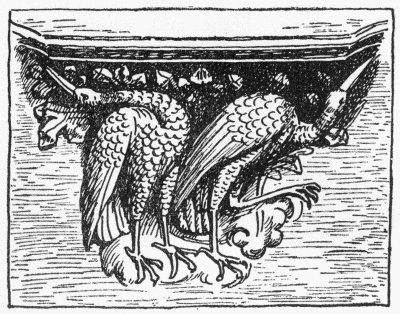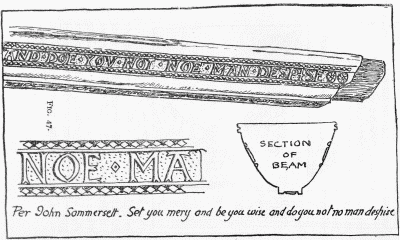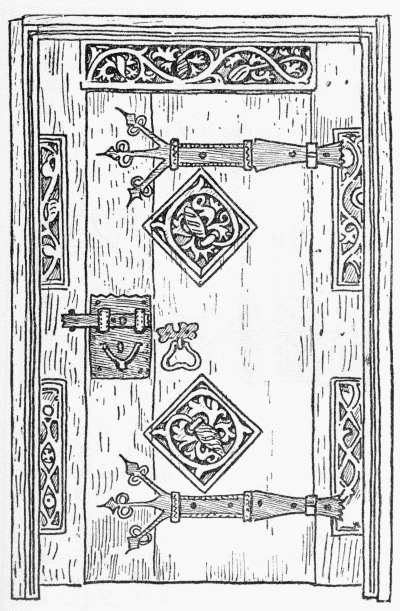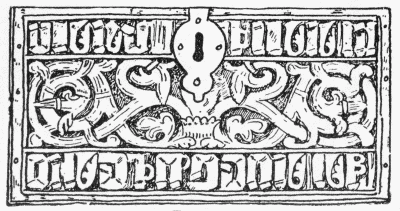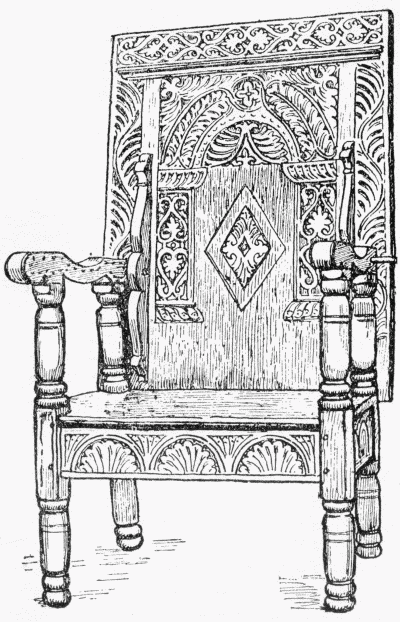CHAPTER XV
THE SKETCH-BOOK
Old Work Best Seen in its Original Place - Museums to be Approached with Caution - Methodical Memoranda - Some Examples - Assimilation of Ideas Better than Making Exact Copies.
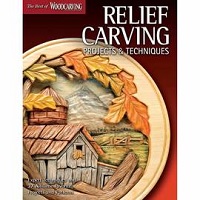
CLICK HERE CLICK HERE In holiday time, and as other opportunity arises, be sure to visit some old building, be it church or mansion. In this way you will make acquaintance with many a fine specimen of old work which will set your fancy moving. In the one there may be a carved choir-screen or bench ends, in [138] the other a fireplace or table. The first sight of such things in the places and among the surroundings for which they were designed, is always an eventful moment in the training of a carver, because the element of surprise acts like a tonic to the mind by arousing its emulative instincts. It is by seeing such things in their proper home and associations that the best lessons are learned. One sees in that way, for instance, why the tool marks left by the old carvers on their work
look more effective than smoothly perfect surfaces, when associated with the rough timbers of the roof, or the uneven surface of the plastered wall. One sees, too, the effect of time and friction in the polished surfaces of bench ends, rubbed and dusted by countless hands until they have become smooth to the eye and touch, and a mental note is made to avoid sharp or spiky work in anything that is likely to be within reach of the fingers.
In this way a certain balance is given to the judgment in proportioning to each piece of work its due share of labor, and we come away with a fixed determination to pay more attention in future to breadth of design and economy of actual carving, a problem which no carver [139] finds easy, but which must be faced if wasted work is not to be his only reward.
[141] In museums, too, we shall find many useful lessons, although there we see things huddled together in a distracting fashion which demands great wariness of selection. The great point to be observed in making our notes for future reference is, that each sketch should contain some memorandum of a special quality, the one which attracted us at the time of making it. One may be made for sake of a general arrangement, another to remind us of some striking piece of detail or [142] peculiarity of execution. The drawings need not be elaborate or labored, provided they make clear the points they were intended to record. Thus Fig. 46 is a sketch which is meant as a memorandum of a lively representation of birds, taken from an old Miserere seat. Fig. 47 was done for sake of the rich effect of an inscription on the plain side of a beam, and also for the peculiar and interesting section to which the beam had been cut. Fig. 48, again, for sake of the arrangement of the little panels on a plain surface, and the sense of fitness and proportion which prompted the carver to dispose his work in that fashion, by which he has enriched the whole surface at little cost of labor, and by contrast enhanced [143] the value of the little strips and diamonds of carved work, otherwise of no particular interest. Figs. 49 and 50 are two sketches of Icelandic carved boxes. Fig. 49 was drawn as an example of the rich effect which that kind of engraved work may have, and of the use which it makes of closely packed letters in the inscription. The pattern is, of course, a traditional Norse one, although the carving is comparatively modern. The points to be noted in the other box were its quaint [144] and simple construction, the use of the letters as decoration, more especially the unpremeditated manner in which they have been grouped, the four letters below making a short line which is eked out by a rude bit of ornament. The letters are cut right through the wood, and are surrounded with an engraved line. Fig. 51 was noted on account of the way in [146] which a very simple pierced ornament is made much of by repetition. The ornament is on a Portuguese bed, and this is only a detail of a small portion. The effect greatly depends upon the quantity, but in this case that is a point which is easily remembered without drawing more of it than is shown. The fact that this work is associated with richly turned balusters is, however, noticed in the sketch, as that might easily be forgotten. Figs. 47 to 51 are from South Kensington Museum.
Then we come to the sketch of a chair (Fig. 52), or combined table and chair. The richly carved back is pivoted, and forms the table top when lowered over the arms, upon which it rests. The points to be noted in this are, the general richness of effect, the contrast of wavy and rigid lines, and the happy way in which the architectural suggestion of arch and pillars has been translated into ornament. As this sketch was not made so much for the chair itself as for its enriched back, no measurements have been taken; otherwise chairs, as such, depend very much upon exact dimensions for their proportions. This chair is at Exning in Suffolk.
Now we shall suppose that you are [147] going to make many such sketches both in museums and in country churches or houses. You will find some too elaborate for drawings in the time at your disposal, in which case you should obtain a photograph, if possible, making notes of any detail which you wish particularly to rememberósuch, for instance, as the carved chest shown in Plate I. The subject, St. George and the Dragon, is given with various incidents all in the one picture. This is a valuable and suggestive piece of work to have before you, as the manner in which the pictorial element has been managed is strikingly characteristic of the carver's methods, and well adapted to the conditions of a technique which has no other legitimate means of dealing with distant objects. The king and queen, looking out of the palace windows, are almost on the same scale as the figures in the foreground; the walls of the houses, roofs, etc., have apparently quite as much projection as the foreground rocksódistance is inferred rather than expressed. The very simple construction, too, is worth noting. It is practically composed of three boards, a wide one for the picture, and two narrower ones for ends and feet. [148]
The object in making these sketches should be mainly to collect a variety of ideas which may brighten the mind when there is occasion to use its inventive faculties. Suggestive hints are wanted; rarely will it be possible, or wise, to repeat anything exactly as you see it. These sketches, if made with care, and from what Constable used to call "breeding subjects," will give your fancy a very necessary point of vantage, from which it may hazard flights of its own.
As much of our knowledge must necessarily be gained from museums, and as they now form such an important feature of educational machinery, I think it will be well to devote a word or two of special notice to the drawbacks which accompany their many advantages. This I propose to do in the following chapter. [149]

|
INFORMATION ABOUT HOW TO MAKE MONEY FROM WOOD CARVING |


